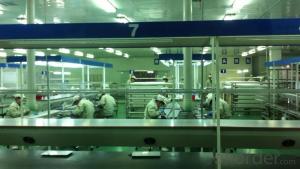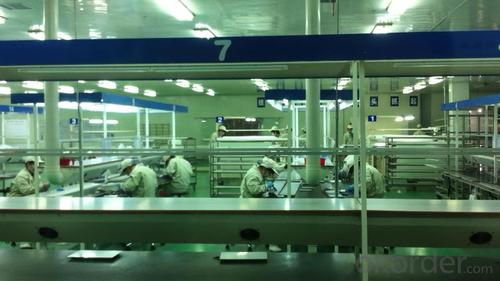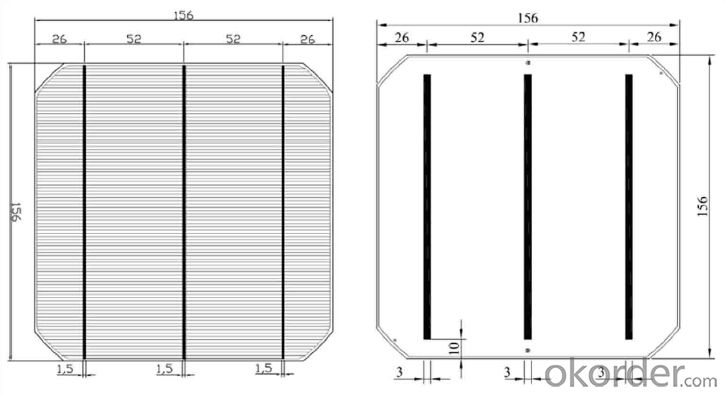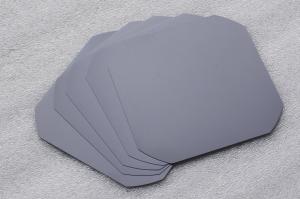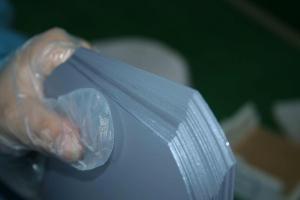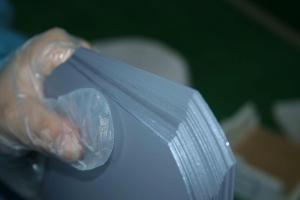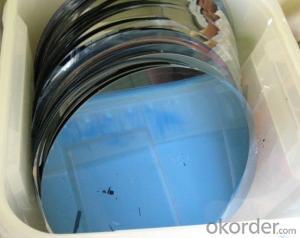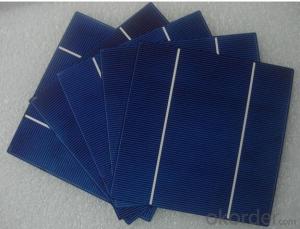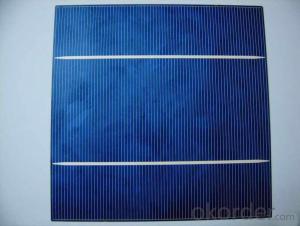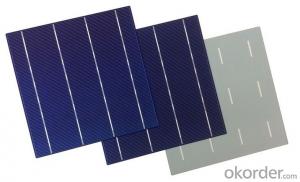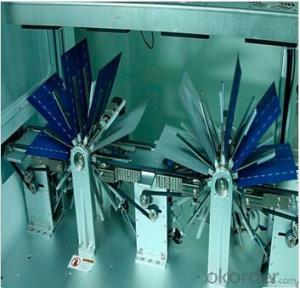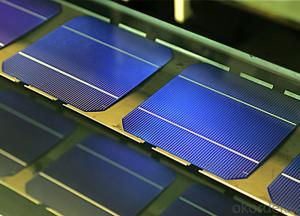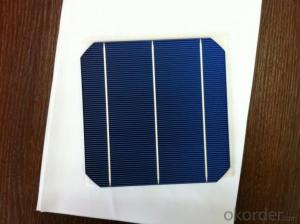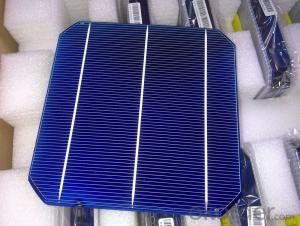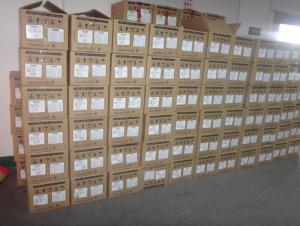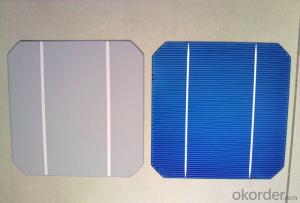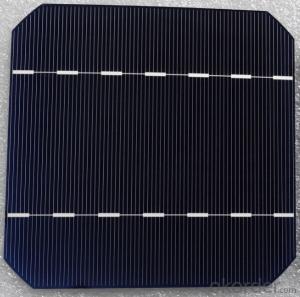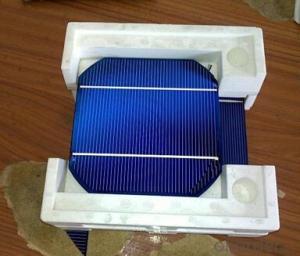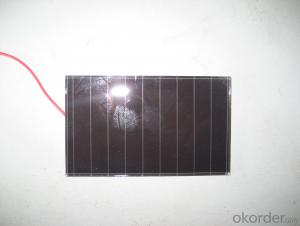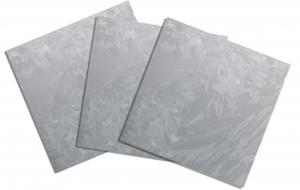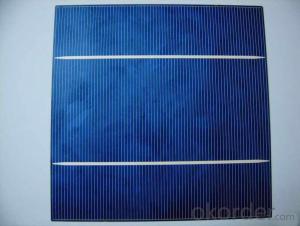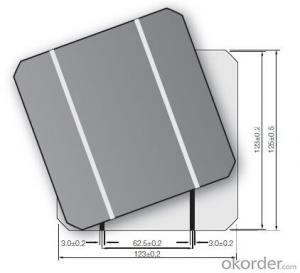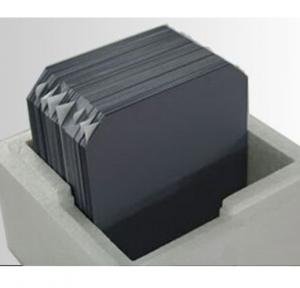Silicon Solar Wafer - Mono Solar Cells 156mm*156mm in Bulk Quantity Low Price Stock 19.0
- Loading Port:
- Shanghai
- Payment Terms:
- TT OR LC
- Min Order Qty:
- 1000 pc
- Supply Capability:
- 100000 pc/month
OKorder Service Pledge
OKorder Financial Service
You Might Also Like
Brief Introduction
- Up to 20.0% efficiency, one of the highest performing mono crystalline cells on the market
- Three bus bars boosts current collection over the entire cell area, leading to higher fill factors
- Blue anti-reflecting coating allows more sunlight be captured and converted to electricity
- Finer, closer fingers improves charge collections for improved energy yield
- Lower light-induced degradation leads to greater power output over the entire module lifetime
- All solar cells are tightly classified to optimize output of module
- Maximum yield and longevity due to hotspot prevention
- Premium appearance results in a highly uniform and aesthetically appealing module
Specification
- Product Mono-crystalline silicon solar cell
- Dimension 156 mm x 156 mm ± 0.5 mm
- Thickness 200 μm ± 30 μm
- Front 1.5 ± 0.1 mm busbar (silver)
- Silicon nitride antireflection coating
- Back 3.0 mm continuous soldering pads (silver)
- Back surface field (aluminum)
Electric performance parameters

- Testing conditions: 1000 W/m2, AM 1.5, 25 °C, Tolerance: Efficiency ± 0.2% abs., Pmpp ±1.5% rel.
- Imin : at 0.5 V
Light Intensity Dependence
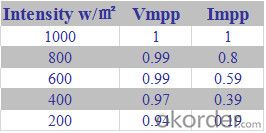
Soldering Ability
- Peel Strength: > 1.0 N/mm (Pull soldered ribbon from busbar in 5 mm/s of 180°)
Dimension Figure
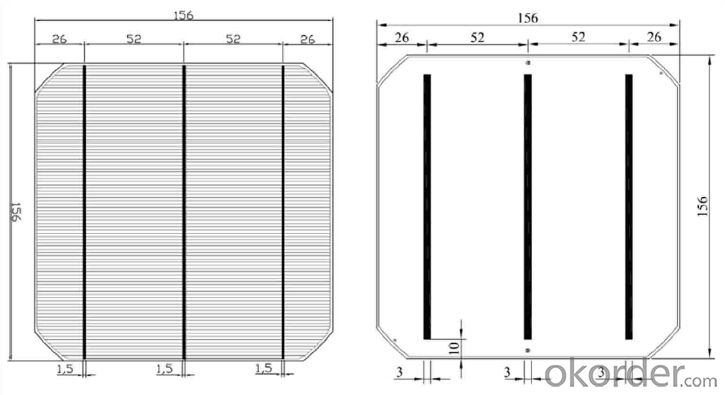
Quick Response
- Any time and anywhere, reply clients' email and solve all problems happen in the work at the first time.
- Remove clients doubts and offer the best solution at the first time.
- Give our clients the lastest news of the photovoltaic, update the newest stock informtion.
Production and Quality Control
- Precision cell efficiency sorting procedures
- Stringent criteria for color uniformity and appearance
- Reverse current and shunt resistance screening
- ISO9001,ISO14001 and OHSAS 18001,TUV Certificated
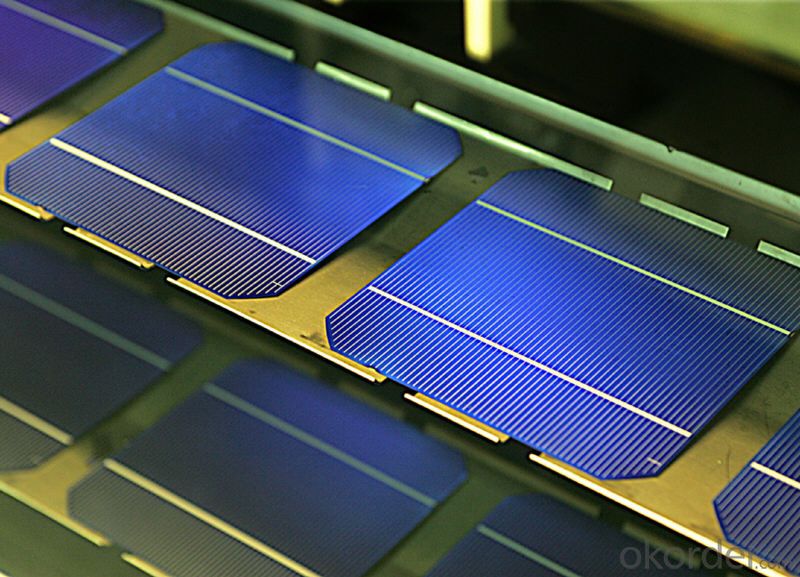
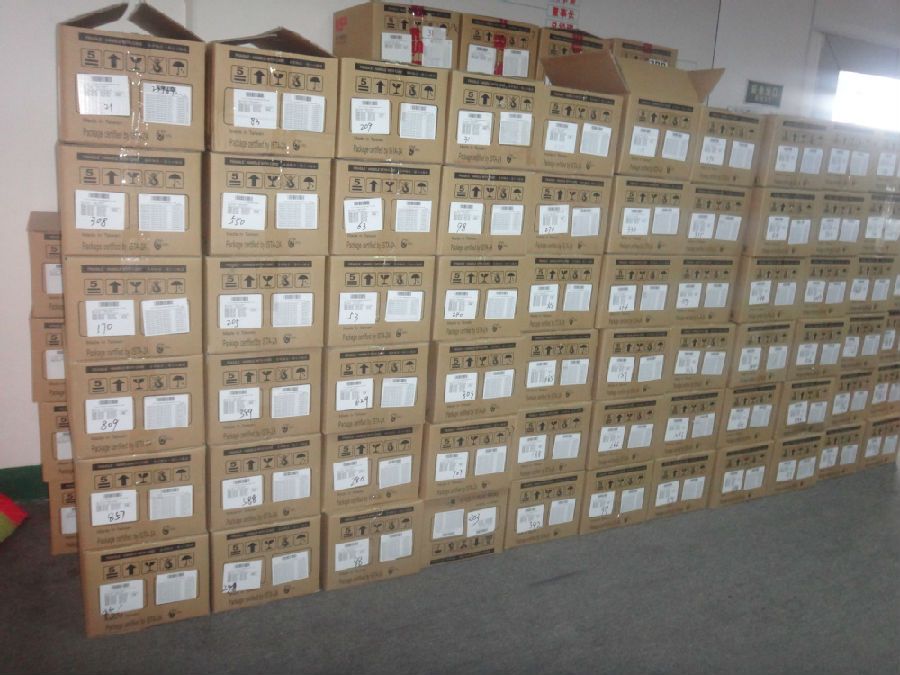
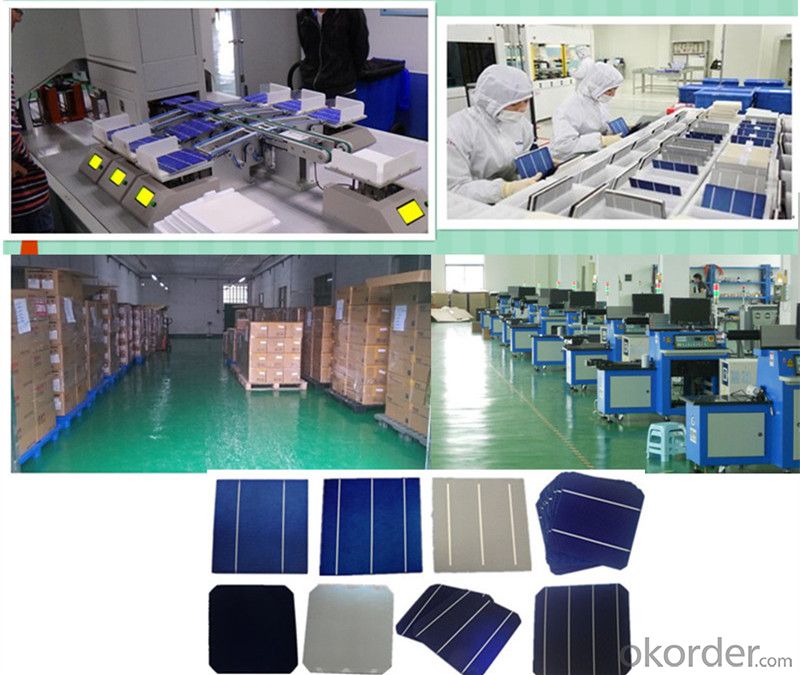
FAQ:
1. Q: Do you have your own factory?
A: Yes, we have. Our factory located in Jiangsu
2. Q: How can I visit your factory?
A: Before you visit,please contact us.We will show you the route or arrange a car to pick you up.
3. Q: Do you provide free sample?
A: Commenly we provide paid sample.
4. Q: Could you print our company LOGO on the nameplate and package?
A: Yes, we accept it.And need an Authorization Letter from you.
5. Q: Do you accept custom design on size?
A: Yes, if the size is reasonable.
6. Q: How can I be your agent in my country?
A: Please leave feedback. It's better for us to talk about details by email.
7. Q: Do you have solar project engineer who can guide me to install system?
A: Yes, we have a professional engineer team. They can teach you how to install a solar system.
- Q: How do solar silicon wafers perform in low humidity conditions?
- Solar silicon wafers generally perform well in low humidity conditions. The low humidity helps in reducing the chances of moisture absorption and corrosion on the wafer's surface, leading to better long-term performance and stability. Additionally, low humidity conditions can enhance the overall efficiency of solar cells, as they experience lower resistance and improved electrical conductivity.
- Q: What is the role of solar silicon wafers in reducing water consumption?
- Solar silicon wafers play a crucial role in reducing water consumption in the production of solar panels. Unlike traditional energy sources, solar energy generation does not require water for its operation. By generating electricity from sunlight using solar silicon wafers, we can significantly reduce the need for water-intensive energy generation methods such as coal or natural gas power plants. This helps conserve water resources, minimize water pollution, and promote a more sustainable and environmentally friendly energy production system.
- Q: Can solar silicon wafers be used in smart city infrastructure?
- Yes, solar silicon wafers can be used in smart city infrastructure. Solar silicon wafers are the key components in solar panels, which can be integrated into various aspects of smart city infrastructure such as streetlights, buildings, and public transportation systems to harness renewable energy. This helps in reducing carbon emissions, promoting sustainability, and providing clean energy for the smart city's operations.
- Q: Wafer cutting will appear thick sheet, I would like to ask what the reasons are
- There is a gap between the guide bar and C. silicon block, cut after the start, with the steel wire operation, part of the guide bar is broken into wire, steel wire dislocation, because the steel line will instantly locate in the cutting process, thus causing the phenomenon of silicon chip thickness.D. guide groove wear serious. Guide for coating of polyurethane materials, cutting knife must guide groove root wear, wheel groove cutting process of cutting steel wire side, in the wheel groove due to sloshing around the lead sheet thickness.
- Q: How are solar silicon wafers protected from physical damage?
- Solar silicon wafers are protected from physical damage through the use of several protective measures. One common method is the application of a thin layer of anti-reflective coating on the surface of the wafer, which not only enhances light absorption but also acts as a protective barrier against scratches and impact. In addition, the wafers are often encapsulated within a transparent, durable material such as tempered glass or polymer sheets, forming a protective module that shields them from external forces. These measures ensure the long-term integrity and performance of the solar silicon wafers.
- Q: Do solar silicon wafers require regular maintenance?
- Yes, solar silicon wafers require regular maintenance to ensure optimal performance and longevity. This includes routine cleaning to remove dirt, dust, and debris that may accumulate on the surface and hinder sunlight absorption. Additionally, periodic inspections and maintenance checks are necessary to identify and address any potential issues such as cracks, corrosion, or faulty connections. Regular maintenance helps to maximize the efficiency and lifespan of solar silicon wafers.
- Q: How do solar silicon wafers contribute to the decentralization of energy production?
- Solar silicon wafers contribute to the decentralization of energy production by enabling the generation of electricity at the point of consumption. By converting sunlight into electricity, solar silicon wafers allow individuals and businesses to produce their own clean energy, reducing their reliance on centralized power grids. This decentralization helps to distribute energy generation across various locations, making the overall energy system more resilient, efficient, and environmentally friendly.
- Q: How do solar silicon wafers contribute to the electrification of remote areas?
- Solar silicon wafers contribute to the electrification of remote areas by being the key component in solar panels, which generate electricity from sunlight. These wafers are made from highly purified silicon and have the ability to convert sunlight into usable electricity through the photovoltaic effect. When installed in remote areas with limited or no access to the traditional power grid, solar panels with silicon wafers can provide a reliable and sustainable source of energy. This enables the electrification of these remote areas, facilitating access to electricity for various purposes such as lighting, powering appliances, and even charging electronic devices.
- Q: Can solar silicon wafers be used in harsh environments?
- Yes, solar silicon wafers can be used in harsh environments. They are designed to withstand various environmental conditions such as extreme temperatures, high humidity, and exposure to UV radiation. The wafers are typically coated with protective materials to enhance their durability and resistance to corrosion, making them suitable for harsh outdoor environments.
- Q: How do solar silicon wafers contribute to energy security?
- Solar silicon wafers contribute to energy security by enabling the production of solar panels, which in turn generate clean and renewable energy. These wafers are essential components of photovoltaic cells, capturing sunlight and converting it into electricity. By harnessing solar power, countries can reduce their dependence on fossil fuels and achieve greater energy self-sufficiency. This diversification of energy sources helps to mitigate the risks associated with volatile fuel prices, geopolitical tensions, and environmental degradation, ultimately strengthening energy security.
Send your message to us
Silicon Solar Wafer - Mono Solar Cells 156mm*156mm in Bulk Quantity Low Price Stock 19.0
- Loading Port:
- Shanghai
- Payment Terms:
- TT OR LC
- Min Order Qty:
- 1000 pc
- Supply Capability:
- 100000 pc/month
OKorder Service Pledge
OKorder Financial Service
Similar products
Hot products
Hot Searches
Related keywords
